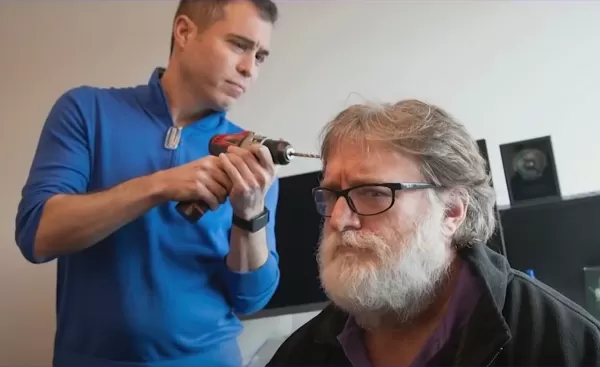Valve CEO Gabe Newell’s Neuralink competitor is expecting its first brain chip this year

Gabe Newell’s Vision: Bridging the Gap Between Brain and PC
It’s no secret that Valve, the powerhouse behind iconic titles like *Half-Life*, *DOTA 2*, and *Counter-Strike*, has always been at the forefront of innovation. But did you know that the company has been quietly exploring the concept of brain-computer interfaces (BCIs) for years? It all started over a decade ago when in-house psychologists began studying players’ biological reactions to video games. At one point, Valve even toyed with the idea of incorporating earlobe monitors into its early VR headset prototypes. Fast forward to 2019, and the company made headlines at GDC when it openly discussed the potential of BCIs for gaming.
However, the idea didn’t stay under Valve’s roof for long. Around the same time, Gabe Newell spun off the concept into a separate venture. Under the radar, he quietly founded a new startup called Starfish Neuroscience. Now, this mysterious company has surfaced with bold ambitions—to unveil its first-ever brain chip later this year.
Introducing Starfish Neuroscience
The startup’s debut blog post, discovered by keen Valve observer Brad Lynch, sheds light on what we can expect. Rest assured, this isn’t some futuristic sci-fi dream—it’s a practical step toward making brain-computer interfaces more accessible. Think of it as a highly advanced “electrophysiology” chip designed to both record brain activity and stimulate neural pathways. While Neuralink can decode thoughts to help patients interact with computers, Starfish aims to achieve similar results—but with a twist. Their focus is on creating a less invasive solution that can access multiple brain regions simultaneously, all without requiring cumbersome batteries.
According to Starfish neuroengineer Nate Cermak, their initial chips are expected to arrive in late 2025. In the meantime, the company is actively seeking collaborators who could leverage this technology to pioneer groundbreaking applications. “We anticipate our first chips arriving in late 2025 and we are interested in finding collaborators for whom such a chip would open new and exciting avenues,” Cermak writes, hinting at potential partnerships with other firms to refine the tech further.
The Tech Behind Starfish’s Chip
So, what makes Starfish’s approach so unique? For starters, their chip is incredibly compact and energy-efficient. Measuring just 2 x 4mm with a 0.3mm pitch BGA, it consumes a mere 1.1 milliwatts during normal operation—a fraction of Neuralink’s N1 chip, which guzzles around 6 milliwatts. Yet, despite its size, it packs impressive capabilities: it supports both recording (spikes and LFP) and stimulation (biphasic pulses), boasts 32 electrode sites, and can handle 16 simultaneous recording channels at 18.75kHz. The chip also features a single current source for arbitrary electrode stimulation, onboard impedance monitoring, and real-time stim voltage transient measurement. Best of all, its digital onboard processing reduces the need for high-bandwidth wireless interfaces, making it easier to integrate into existing devices.
To put things in perspective, Neuralink’s N1 chip boasts 1,024 electrodes spread across 64 threads, but its full implant measures 23mm wide and 8mm thick. In contrast, Starfish envisions something far smaller and less intrusive, focusing on wireless power transmission instead of bulky batteries.
Why Multiple Brain Regions Matter
One of the standout aspects of Starfish’s approach lies in its ambition to target multiple brain regions simultaneously. As Cermak explains, many neurological disorders, such as Parkinson’s disease, stem from circuit-level dysfunctions where interactions between different brain areas go awry. By enabling access to multiple regions, Starfish hopes to address these complex issues more effectively than previous solutions.
Beyond gaming, the company is also developing tools like a precision hyperthermia device for tumor treatment and a brain-reading, robotically guided TMS system for mental health conditions like bipolar disorder and depression. These innovations could revolutionize fields beyond entertainment.
Back to Gaming: Valve’s Vision Comes Full Circle
If you’re curious about how this ties back to gaming, look no further than Valve’s GDC 2019 presentation. In it, the company outlined the potential of BCIs to enhance immersion, responsiveness, and overall gaming experiences. Imagine a future where your thoughts dictate actions in real-time, eliminating delays and creating seamless connections between mind and machine. While we’re not quite there yet, Starfish’s progress brings us closer than ever.
For now, the possibilities remain tantalizingly close—but within reach.
Related article
 US to Sanction Foreign Officials Over Social Media Regulations
US Takes Stand Against Global Digital Content Regulations
The State Department issued a sharp diplomatic rebuke this week targeting European digital governance policies, signaling escalating tensions over control of online platforms. Secretary Marco
US to Sanction Foreign Officials Over Social Media Regulations
US Takes Stand Against Global Digital Content Regulations
The State Department issued a sharp diplomatic rebuke this week targeting European digital governance policies, signaling escalating tensions over control of online platforms. Secretary Marco
 Anthropic Resolves Legal Case Over AI-Generated Book Piracy
Anthropic has reached a resolution in a significant copyright dispute with US authors, agreeing to a proposed class action settlement that avoids a potentially costly trial. The agreement, filed in court documents this Tuesday, stems from allegations
Anthropic Resolves Legal Case Over AI-Generated Book Piracy
Anthropic has reached a resolution in a significant copyright dispute with US authors, agreeing to a proposed class action settlement that avoids a potentially costly trial. The agreement, filed in court documents this Tuesday, stems from allegations
 Figma Releases AI-Powered App Builder Tool to All Users
Figma Make, the innovative prompt-to-app development platform unveiled earlier this year, has officially exited beta and rolled out to all users. This groundbreaking tool joins the ranks of AI-powered coding assistants like Google's Gemini Code Assis
Comments (4)
0/200
Figma Releases AI-Powered App Builder Tool to All Users
Figma Make, the innovative prompt-to-app development platform unveiled earlier this year, has officially exited beta and rolled out to all users. This groundbreaking tool joins the ranks of AI-powered coding assistants like Google's Gemini Code Assis
Comments (4)
0/200
![JustinJohnson]() JustinJohnson
JustinJohnson
 August 7, 2025 at 3:01:00 PM EDT
August 7, 2025 at 3:01:00 PM EDT
Gabe's diving into brain chips? That's wild! Imagine playing Counter-Strike with just your thoughts—total game-changer. But, like, is this safe? I'm hyped but kinda nervous about plugging my brain into Steam. 😅


 0
0
![BruceWilson]() BruceWilson
BruceWilson
 August 4, 2025 at 2:01:00 AM EDT
August 4, 2025 at 2:01:00 AM EDT
This brain chip stuff from Gabe Newell is wild! Imagine playing Counter-Strike with your thoughts—total sci-fi vibes. But honestly, I’m a bit sketched out about sticking chips in my head. Cool tech, but I’ll stick to my keyboard for now! 😅


 0
0
![BrianWalker]() BrianWalker
BrianWalker
 July 31, 2025 at 7:35:39 AM EDT
July 31, 2025 at 7:35:39 AM EDT
Mind-blowing stuff! Gabe Newell jumping into brain chips feels like a sci-fi plot twist. Can't wait to see if this rivals Neuralink or just becomes a niche gaming gimmick. 🧠🎮


 0
0
![WillWalker]() WillWalker
WillWalker
 July 29, 2025 at 8:25:16 AM EDT
July 29, 2025 at 8:25:16 AM EDT
Gabe Newell diving into brain chips is wild! I mean, from Steam to messing with our neurons? Curious how this stacks up against Neuralink, but I’m lowkey worried about ads popping up in my head while gaming. 😅


 0
0

Gabe Newell’s Vision: Bridging the Gap Between Brain and PC
It’s no secret that Valve, the powerhouse behind iconic titles like *Half-Life*, *DOTA 2*, and *Counter-Strike*, has always been at the forefront of innovation. But did you know that the company has been quietly exploring the concept of brain-computer interfaces (BCIs) for years? It all started over a decade ago when in-house psychologists began studying players’ biological reactions to video games. At one point, Valve even toyed with the idea of incorporating earlobe monitors into its early VR headset prototypes. Fast forward to 2019, and the company made headlines at GDC when it openly discussed the potential of BCIs for gaming. However, the idea didn’t stay under Valve’s roof for long. Around the same time, Gabe Newell spun off the concept into a separate venture. Under the radar, he quietly founded a new startup called Starfish Neuroscience. Now, this mysterious company has surfaced with bold ambitions—to unveil its first-ever brain chip later this year.Introducing Starfish Neuroscience
The startup’s debut blog post, discovered by keen Valve observer Brad Lynch, sheds light on what we can expect. Rest assured, this isn’t some futuristic sci-fi dream—it’s a practical step toward making brain-computer interfaces more accessible. Think of it as a highly advanced “electrophysiology” chip designed to both record brain activity and stimulate neural pathways. While Neuralink can decode thoughts to help patients interact with computers, Starfish aims to achieve similar results—but with a twist. Their focus is on creating a less invasive solution that can access multiple brain regions simultaneously, all without requiring cumbersome batteries. According to Starfish neuroengineer Nate Cermak, their initial chips are expected to arrive in late 2025. In the meantime, the company is actively seeking collaborators who could leverage this technology to pioneer groundbreaking applications. “We anticipate our first chips arriving in late 2025 and we are interested in finding collaborators for whom such a chip would open new and exciting avenues,” Cermak writes, hinting at potential partnerships with other firms to refine the tech further.The Tech Behind Starfish’s Chip
So, what makes Starfish’s approach so unique? For starters, their chip is incredibly compact and energy-efficient. Measuring just 2 x 4mm with a 0.3mm pitch BGA, it consumes a mere 1.1 milliwatts during normal operation—a fraction of Neuralink’s N1 chip, which guzzles around 6 milliwatts. Yet, despite its size, it packs impressive capabilities: it supports both recording (spikes and LFP) and stimulation (biphasic pulses), boasts 32 electrode sites, and can handle 16 simultaneous recording channels at 18.75kHz. The chip also features a single current source for arbitrary electrode stimulation, onboard impedance monitoring, and real-time stim voltage transient measurement. Best of all, its digital onboard processing reduces the need for high-bandwidth wireless interfaces, making it easier to integrate into existing devices. To put things in perspective, Neuralink’s N1 chip boasts 1,024 electrodes spread across 64 threads, but its full implant measures 23mm wide and 8mm thick. In contrast, Starfish envisions something far smaller and less intrusive, focusing on wireless power transmission instead of bulky batteries.Why Multiple Brain Regions Matter
One of the standout aspects of Starfish’s approach lies in its ambition to target multiple brain regions simultaneously. As Cermak explains, many neurological disorders, such as Parkinson’s disease, stem from circuit-level dysfunctions where interactions between different brain areas go awry. By enabling access to multiple regions, Starfish hopes to address these complex issues more effectively than previous solutions. Beyond gaming, the company is also developing tools like a precision hyperthermia device for tumor treatment and a brain-reading, robotically guided TMS system for mental health conditions like bipolar disorder and depression. These innovations could revolutionize fields beyond entertainment.Back to Gaming: Valve’s Vision Comes Full Circle
If you’re curious about how this ties back to gaming, look no further than Valve’s GDC 2019 presentation. In it, the company outlined the potential of BCIs to enhance immersion, responsiveness, and overall gaming experiences. Imagine a future where your thoughts dictate actions in real-time, eliminating delays and creating seamless connections between mind and machine. While we’re not quite there yet, Starfish’s progress brings us closer than ever. For now, the possibilities remain tantalizingly close—but within reach. US to Sanction Foreign Officials Over Social Media Regulations
US Takes Stand Against Global Digital Content Regulations
The State Department issued a sharp diplomatic rebuke this week targeting European digital governance policies, signaling escalating tensions over control of online platforms. Secretary Marco
US to Sanction Foreign Officials Over Social Media Regulations
US Takes Stand Against Global Digital Content Regulations
The State Department issued a sharp diplomatic rebuke this week targeting European digital governance policies, signaling escalating tensions over control of online platforms. Secretary Marco
 Anthropic Resolves Legal Case Over AI-Generated Book Piracy
Anthropic has reached a resolution in a significant copyright dispute with US authors, agreeing to a proposed class action settlement that avoids a potentially costly trial. The agreement, filed in court documents this Tuesday, stems from allegations
Anthropic Resolves Legal Case Over AI-Generated Book Piracy
Anthropic has reached a resolution in a significant copyright dispute with US authors, agreeing to a proposed class action settlement that avoids a potentially costly trial. The agreement, filed in court documents this Tuesday, stems from allegations
 Figma Releases AI-Powered App Builder Tool to All Users
Figma Make, the innovative prompt-to-app development platform unveiled earlier this year, has officially exited beta and rolled out to all users. This groundbreaking tool joins the ranks of AI-powered coding assistants like Google's Gemini Code Assis
Figma Releases AI-Powered App Builder Tool to All Users
Figma Make, the innovative prompt-to-app development platform unveiled earlier this year, has officially exited beta and rolled out to all users. This groundbreaking tool joins the ranks of AI-powered coding assistants like Google's Gemini Code Assis
 August 7, 2025 at 3:01:00 PM EDT
August 7, 2025 at 3:01:00 PM EDT
Gabe's diving into brain chips? That's wild! Imagine playing Counter-Strike with just your thoughts—total game-changer. But, like, is this safe? I'm hyped but kinda nervous about plugging my brain into Steam. 😅


 0
0
 August 4, 2025 at 2:01:00 AM EDT
August 4, 2025 at 2:01:00 AM EDT
This brain chip stuff from Gabe Newell is wild! Imagine playing Counter-Strike with your thoughts—total sci-fi vibes. But honestly, I’m a bit sketched out about sticking chips in my head. Cool tech, but I’ll stick to my keyboard for now! 😅


 0
0
 July 31, 2025 at 7:35:39 AM EDT
July 31, 2025 at 7:35:39 AM EDT
Mind-blowing stuff! Gabe Newell jumping into brain chips feels like a sci-fi plot twist. Can't wait to see if this rivals Neuralink or just becomes a niche gaming gimmick. 🧠🎮


 0
0
 July 29, 2025 at 8:25:16 AM EDT
July 29, 2025 at 8:25:16 AM EDT
Gabe Newell diving into brain chips is wild! I mean, from Steam to messing with our neurons? Curious how this stacks up against Neuralink, but I’m lowkey worried about ads popping up in my head while gaming. 😅


 0
0





























